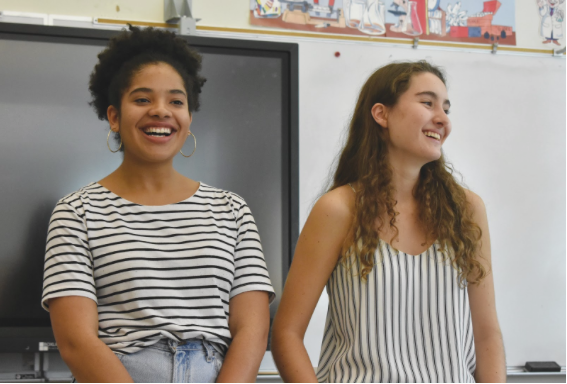500 Women Scientists inspires girls to pursue STEM fields
More stories from Lauren Silcock

Senior Keziah Corbett and junior Katherine Esterl head the club’s first interest meeting with the new club members.
In a classroom on the C400 hall, a group of around 40 students shuffle in after school. Twelve of these students are freshmen, and only two of the students are male. Within a few minutes, the room is packed. The only adult in the room is Dr. Cofield, the teacher sponsor, who sits silently at her desk.
Senior Keziah Corbett and junior Katherine Esterl stand in front of the promethean board. They smile broadly at the gathered students, and begin to explain the goals of the club. This is the first meeting of the year of the Grady chapter of 500 Women Scientists.
“It’s almost like a union of women scientists,” said Corbett and Esterl in unison. “We’ve brought it down to the high school level.”
Corbett and Esterl are co-presidents of the club. They run the meetings and organize events for the club members. Typically, meetings feature a woman scientist who lectures and answers questions.
“Today we really just want to learn a lot about what you guys are interested in,” says Corbett.
The club was founded last year by then-senior Chandler Morris. Morris, currently a freshman at Columbia University, discovered the 500 Women Scientists organization through her mentor, Kim Cobb.
Cobb works in paleoclimate science at Georgia Tech, and is also a board member of the Atlanta branch of 500 Women Scientists. Morris was inspired to bring the experience to teens at Grady.
“There weren’t many youth organizations, if any, in the country, but there were a lot of adult branches throughout the country,” said Morris. “There’s one in New York City, one in Denver, they’re all over. I thought it was a really cool movement and…I thought that would be really cool to bring to Grady.”
500 Women Scientists is a worldwide organization with groups across the globe. Nationally, the goal is to empower women through science and advocate for equality. At the high school level, the goal is far more personal.
“Our goal is to motivate women and … men who join the club to pursue their goals in STEM, to help them find mentors, and to create clusters of people who are interested in the same topic.” said Corbett. “We’re fine tuning your interest in STEM.”
Dr. Cofield may be the club’s sponsor, but the club is completely student led.
“The club being student-led really just makes it more approachable,” said Morris. “I think the goal really is to make the traditionally ‘harder classes’ feel more accessible and more attainable for everybody … I think when it’s student led, it’s more of your peers saying ‘Hey, this is something that I’m doing and you can do to.’ … You have people from different friend groups, different activities, just everybody doing it. It’s not just something that’s for one type of person. It’s for everybody.”
